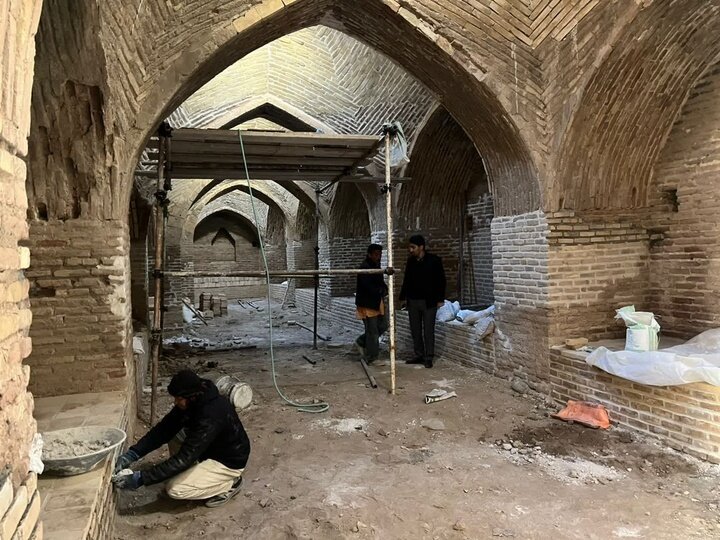Restoration of 17th-century Aveh caravanserai underway

TEHRAN - A new phase of restoration work has commenced on a Shah Abbasi Caravanserai in the historic town of Aveh, located in Saveh county of Markazi province.
The current phase of the restoration involves key activities such as replacing eroded bricks, repointing and paving completed sections, and traditional waterproofing to enhance the structure’s durability and visitor experience, the deputy provincial tourism chief said on Thursday.
During a visit to the site, Hossein Mahmoudi, also emphasized the cultural and historical significance of the once prosperous caravanserai.
The official highlighted the architectural and locational importance of the Aveh caravanserai, noting its potential as a major tourist attraction in the province. “Caravanserais played a vital role in the past as rest stops and supply centers for travelers, contributing to the development of trade and cultural exchange.
“Today, by restoring them, we preserve this invaluable heritage.”
He further noted that the restoration of the Aveh caravanserai not only preserves history and culture but also serves as an economic opportunity to attract tourists. “With proper infrastructure and management, this site can provide a unique experience for visitors,” Mahmoudi added. “We must maximize these opportunities and prepare the necessary facilities for tourists.”
Moreover, Mahmoudi highlighted the potential for job creation and economic growth in the area, noting that an increase in tourist numbers would help local businesses thrive, ultimately improving the quality of life for residents.
It is one of the 999 caravanserais constructed upon the order of Shah Abbas the Great, who was the fifth Safavid shah of Iran from 1588 to 1629.
The monument enjoys a symmetrical plan of four iwans, representing the classic form of a caravanserai. It consists of various sections, including a vast central courtyard, entrance, lodging chambers, and stables.
For long, Iranian caravanserais have been a testimony to the rich circuits of traveling and trade in ancient Iran, providing shelter, food, and water for caravans, pilgrims, and other trekkers.
Caravanserai, derived from the compound of "caravan" and "Sara," symbolized a haven for groups of travelers. These structures typically boasted massive portals supported by sturdy walls, with guest rooms encircling a central courtyard and stables tucked behind them, often accessible through yard corners. The earliest caravanserais in Iran trace back to the Achaemenid era (c. 550 - 330 BC).
Last year, a selection of 54 centuries-old roadside inns won a UNESCO label under the name: The Persian Caravanserai. The registration was made at the 45th session of the UNESCO World Heritage Committee in Saudi Arabia’s capital Riyadh, after carefully examining the proposed caravanserais located in 24 provinces across the country.
AM
Leave a Comment